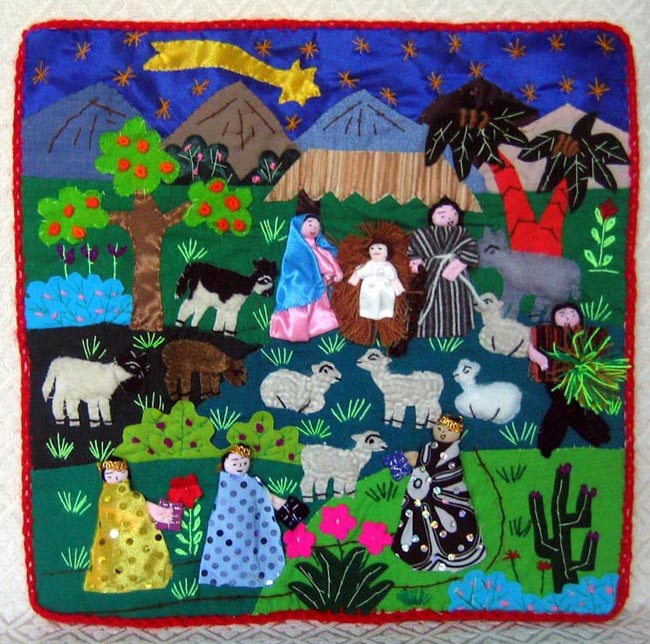OUR COLLECTION — LATIN AMERICA — PERU 272. ARPILLERA NATIVITY HANGING
This Nativity hanging from Peru is called an arpillera, which in Spanish means burlap or sackcloth. Talented women use fabrics of many colors and textures to make this scene. They individually designed and hand-stitched every little detail. The hanging measures 11.5 inches square.
Hand-quilting an arpillera (ar-pee-er-a) takes skill, patience and much imagination. To make each art quilt, the artisan begins by cutting scraps of material and hand-stitching them layer by layer to create a unique landscape. Next, cutouts of animals, trees, houses, etc., are stuffed with a technique called “trapunto.” Dolls are made with colored fabrics, while flowers and other fine details are hand-stitched and embroidered onto the landscape to complete each scene.
The Arpillera folk art tradition began in the early 1970s, when social upheaval in Peru pushed entire Andean communities to migrate to the city. People abandoned their land, home, crops, and animals for settlements in the outskirts of Lima. In search of safety and economic stability, they found something far different. Families were forced to start from scratch. Thanks to their skilled hands and a sense of tradition and creativity, many women from these new communities learned a new skill with the help of German missionaries. Working from home, they could now use this marketable craft to generate income for their families while tending their children.
Hand-quilting an arpillera (ar-pee-er-a) takes skill, patience and much imagination. To make each art quilt, the artisan begins by cutting scraps of material and hand-stitching them layer by layer to create a unique landscape. Next, cutouts of animals, trees, houses, etc., are stuffed with a technique called “trapunto.” Dolls are made with colored fabrics, while flowers and other fine details are hand-stitched and embroidered onto the landscape to complete each scene.
The Arpillera folk art tradition began in the early 1970s, when social upheaval in Peru pushed entire Andean communities to migrate to the city. People abandoned their land, home, crops, and animals for settlements in the outskirts of Lima. In search of safety and economic stability, they found something far different. Families were forced to start from scratch. Thanks to their skilled hands and a sense of tradition and creativity, many women from these new communities learned a new skill with the help of German missionaries. Working from home, they could now use this marketable craft to generate income for their families while tending their children.
